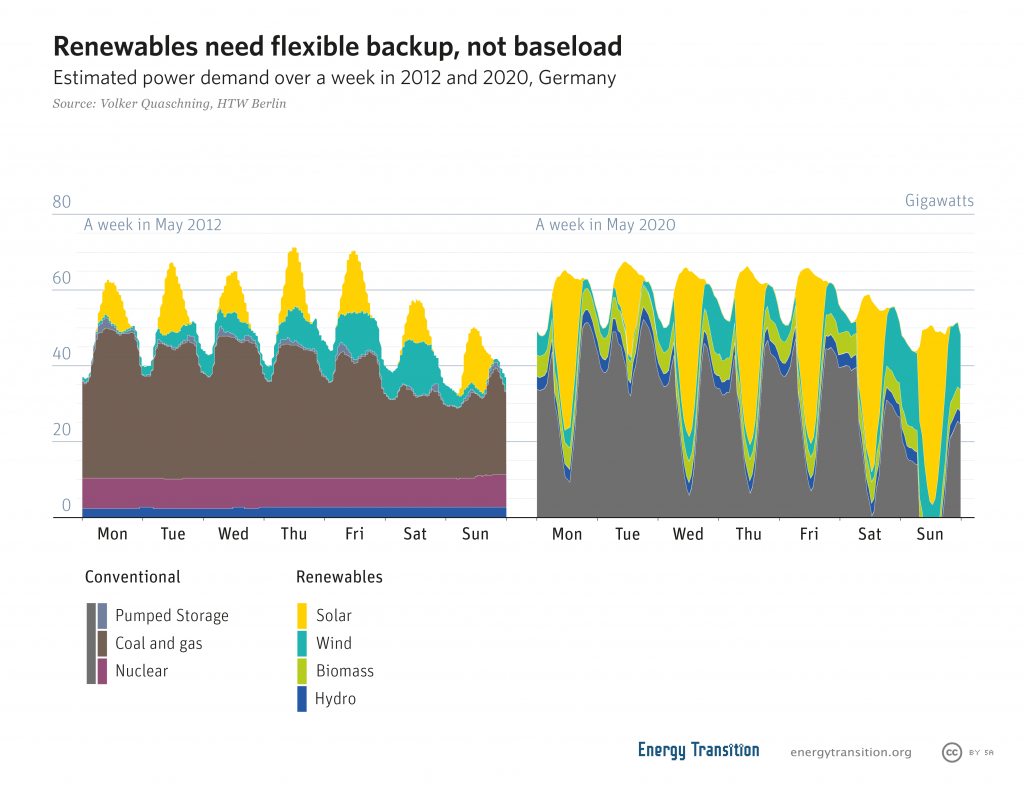Changing the entire energy system isn’t easy – here’s why.
Before solar and wind power became important, the German power system ran on nuclear power (which provided a small, steady baseload) and coal power (which could be ramped up to cover the peak energy demand). Now the energy landscape looks completely different:

Today, much of German power is provided by renewables and cuts deep into the baseload. But to get to 100% renewable energy, two things need to happen: renewables need to be used as efficiently as possible, and energy storage technologies must be improved.
Integrating renewables into the energy grid
To use energy from the sun and wind as efficiently as possible, the German power grid must act intelligently and quickly. This means that power has to be distributed as to where it’s needed as soon as possible – this process can be speeded up by smart grids and demand-side management (e.g. using energy when it’s most plentiful).
However, this means that instead of having an energy grid which is meant to distribute the same amount of power all the time, Germany has to change its grid to be able to move large surges of power quickly. And for this, it needs to expand geographically.
Grid expansion
Up to now, grid expansion has not been progressing fast enough. Lines to connect offshore wind turbines are especially crucial. Current estimates are that Germany needs 7,700 more kilometers of power lines. Of these, 1,750 have permission to be built, and 950 kilometers have been built. The current minister of economics and energy, Peter Altmeier, has placed an emphasis on expanding and improving Germany’s grid to address these issues.
In addition, it’s not clear who should pay for what – for example, if wind turbines had been installed offshore, but the grid connection was not ready. In the summer of 2012, the German government brokered a compromise between wind farm investors and transmission grid operators by resolving that the former would be compensated by the latter, but the costs could be passed on to consumers.
This compromise sets a double standard for wind power. Small onshore wind farms have to pay for their own connections up to the nearest transformer station, and they receive no compensation from grid operators if the capacity behind the transformer station needs to be upgraded and is not done in timely fashion. The onshore wind sector, which has traditionally been driven by community projects and small to midsize businesses, is therefore frustrated because transmission grid operators – former subsidiaries of Germany’s Big Four utilities, which have not always helped small onshore wind farms – are getting special treatment for their grid connections.
Distributed energy
Critics have argued that better distributed energy and phasing out coal would solve the problem of energy bottlenecks. A recent assessment by the Öko Institute, funded by the German government, found that installing more renewable capacities in energy-intensive regions would make grid expansion less necessary, and warned that acting without knowing anything about the coal phaseout could mean overbuilding or building lines in the wrong places. To quote energy expert Henrik Maatsch, “The existing power lines could transmit a lot more renewable energy if they weren’t stuffed with fossil fuels.”
Storing renewable energy
Even if Germany manages to use its renewable energy as efficiently as possible, it will still need to have stored energy which can kick in when the wind and sun aren’t providing enough. Therefore Germany is investing in energy storage, such as pumped storage and batteries.
Pumped storage
On very sunny or very windy days, pumped storage plants use excess energy to move water uphill into a reservoir. Then, when the power is needed, the water is released and generates energy. Basically, it is a specific type of hydropower which can be switched on quickly to fill gaps. In 2015, about 8 TWH of electricity were stored in pumped plants in Germany. In general, pumped storage has grown slowly because Germany has focused on improving connections with its European neighbors and exporting when necessary.
Battery storage
Industrial-size battery storage plants have taken off in the past years: far from being a niche technology, it now holds the potential to replace conventional power generators. Battery storage systems are online in Greece, South Africa, South Korea, and Australia. Australia’s Tesla battery, which is paired with a wind farm and sells energy back to the grid when necessary, made back a third of its cost in only one year.
Germany is trying to position itself as a European center for factories where batteries are produced. Its volume of battery storage is relatively small, and more focused on stabilizing the grid than providing large amounts of storage. This may be because in most cases, battery storage does not benefit from subsidies, making investors less likely to connect to the grid right away. As the solar industry benefitted from feed-in tariffs investors could be sure that they would have a certain amount of returns on their profit – a similar scheme could help more batteries come online.
The European Commission recently established the European Battery Alliance, providing 110 million euros for research and development through 2019. Europe may need as many as 10-20 lithium ion battery factories to meet new demand for storage and for electric vehicles. This market which could be worth up to 250 billion euros a year according to some estimates.
Turning energy into gas
Germany also plans to use eventually use sustainable biogas and hydrogen made from excess wind power and solar power. Solar and wind power can be stored as a gas (called “power to gas” or P2G), allowing it to be used as a motor fuel, for heat applications, or to produce dispatchable power.